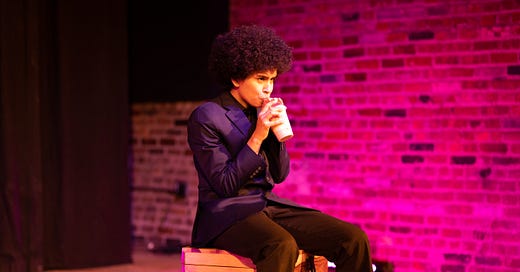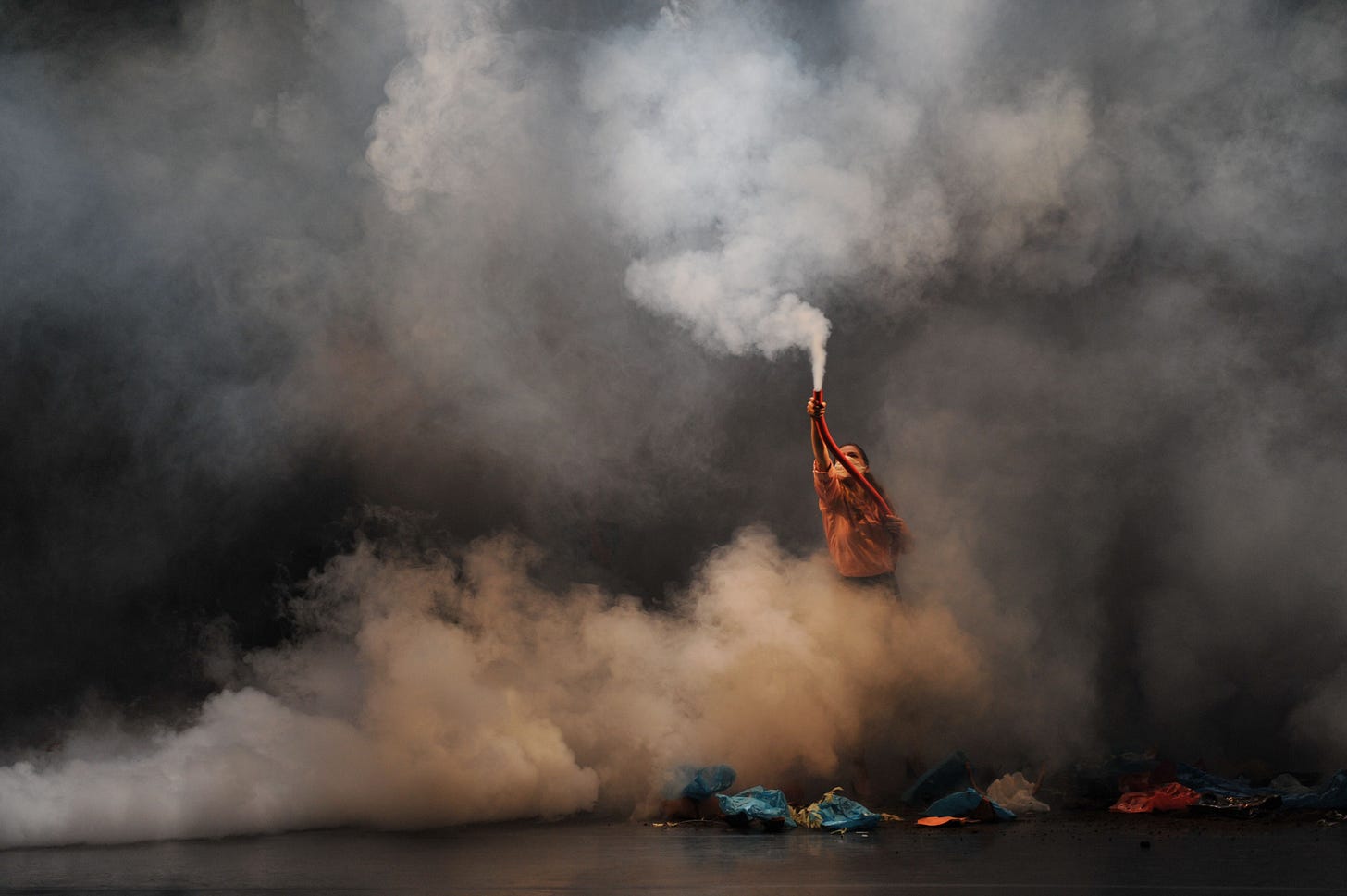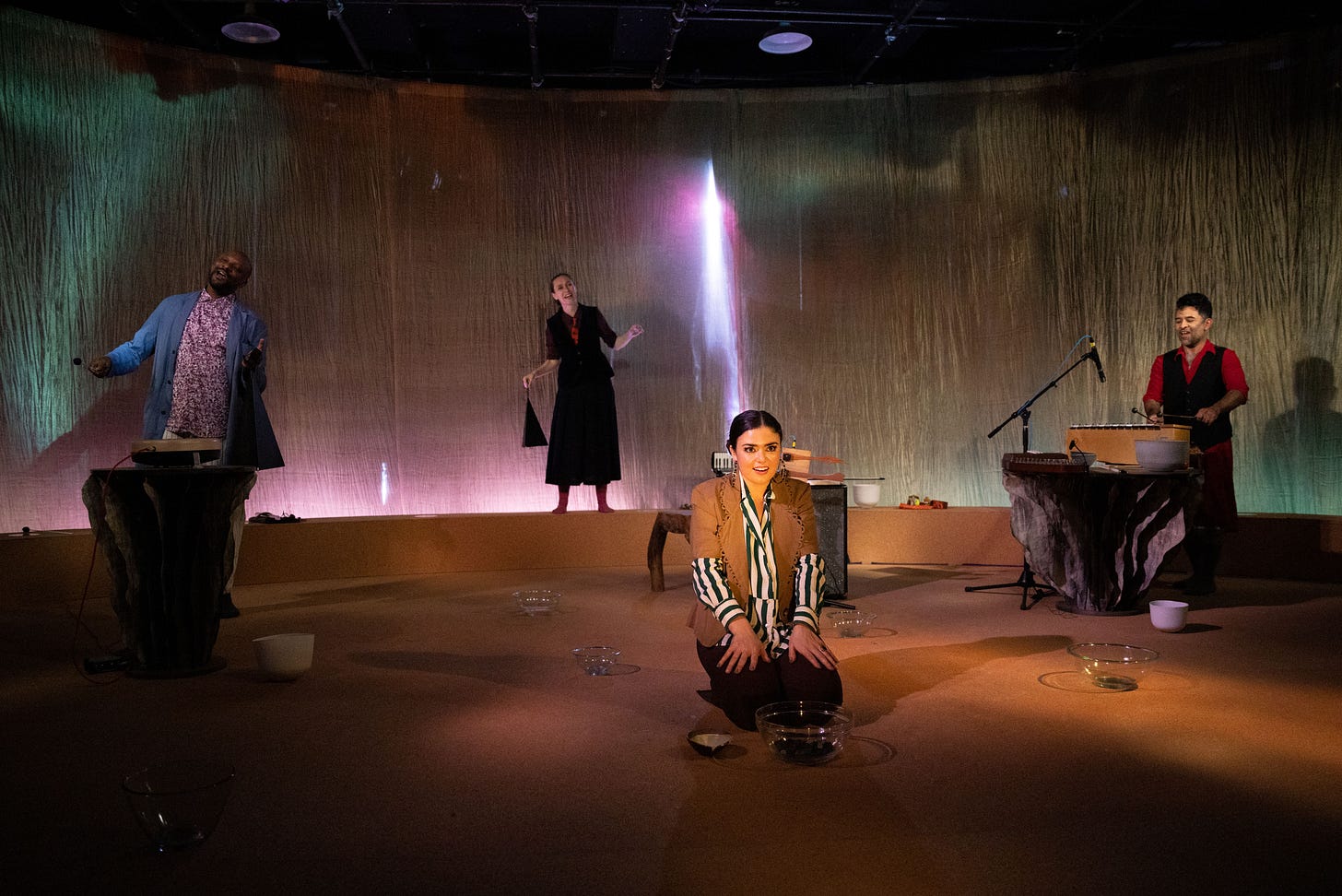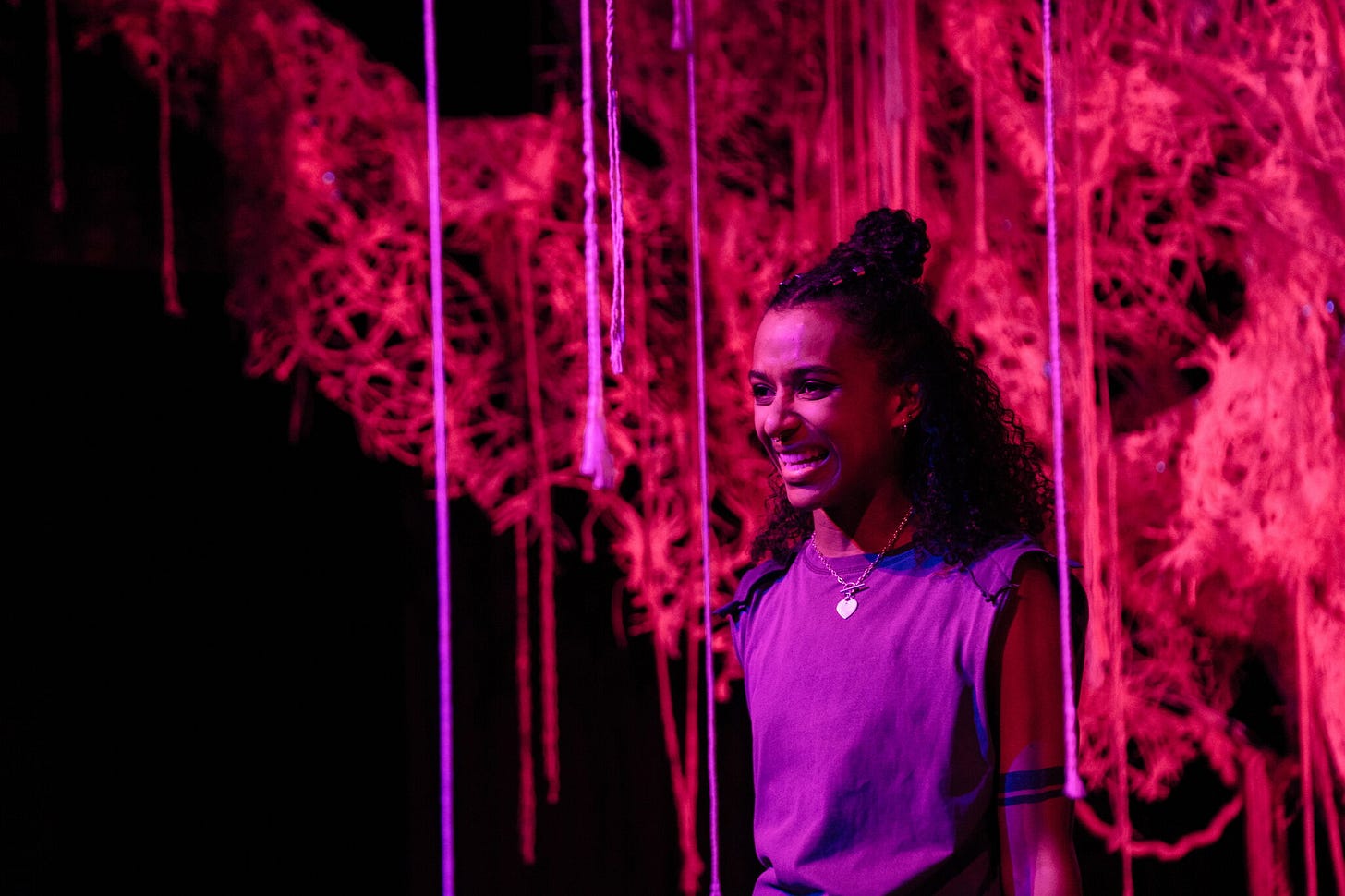January Festival Round-Up
Under the Radar, Exponential & Prototype all return for a packed festival season
Are we not drawn onward to new erA
Under the Radar; presented at BAM Fisher; created by Ontroerend Goed
A tree, with an apple dangling from one branch, sits on a bare stage. A woman walks to the tree, grabs the apple and takes a bite. A man watches. The two seem to carry the world with them.
Are we not drawn onward to new erA starts slow. A few more figures join the two on stage. All proceed to trash the place. Then religion takes hold, and they erect a huge statue of a deity.
It’s engaging even before the point becomes clear, mostly because the actors are speaking backwards. And based on their strange, herky-jerk physicality, perhaps also moving backwards? It’s like a trip into the Red Room from Twin Peaks, but entirely performed live.
Then, at the halfway point, the show comes into focus. Having thoroughly wrecked their world, the figures on stage express a wish to go back and undo all of their horrible mistakes. But that’s impossible, right?
A screen descends, and the entire show we just saw is run backwards—which is actually forwards. Destruction becomes clean-up. The statue raising becomes the tearing down of a false idol. And the dialogue, previously garbled nonsense, is crystal clear.
At first, this turn feels like the show contradicting its own message about how we move forward with our planet. After all, we cannot simply reverse every bit of damage we’ve done, like running back a tape. Surely the answer is doing better as we move forward, with what we still have?
But as the footage keeps playing, and scenes we just watched take on new or more interesting meanings, the point becomes clear. We cannot literally reverse every action we have taken, but we do have far more power than we know. If we achieved the feat of raising huge buildings and covering the Earth with our chaos, why is the reverse somehow viewed as total impossibility? The impossible can be possible—in fact, we’ve already achieved it, many times over.
A Thousand Ways (Part Three): An Assembly
Under the Radar; presented at The New York Public Library; created by 600 Highwaymen
“I don’t like this sort of thing,” an audience member announces.
The prompt had been: Why are you feeling anxious right now?
A Thousand Ways has proven effective, in all three of its parts, in quickly dispelling such nervousness. Part One was a facilitated phone call between two strangers at the height of lockdown. Part Two was an in-person conversation, guided by cards, between two strangers divided by plexiglass. Now comes the final part, a series of communal exercises—again guided by cards—shared by 16 strangers.
In all three parts, the prompts provided by creators Abigail Browde and Michael Silverstone have walked a careful line between self-help and corporate retreat, gently encouraging participants to let their guard down without getting overly cutesy. Though Part Three is slightly less successful in this regard, it is still a moving capstone to the experience.
This time around, some of the prompts feel a bit awkward. Questions like, “Who uses a hearing aid?” or “Who has a metal plate?” seem unnecessarily revealing, to no real end. Recurring imagery of a vaguely apocalyptic, dust bowl-like future also feels unclear in purpose.
Yet joining with these strangers does, as in previous parts, place you under a strange spell—something almost like déjà vu. My group moved from, “I don’t like this kind of thing,” to a startling intimacy in no time at all.
It works because the words on the cards come to feel natural, as though they actually came from within yourself. At one point I was instructed to gather the group around me on the floor, while I sat on a chair before them, like a teacher at story time. Then I reported: “I don’t think things will get better.” I don’t know if I believe that. But as I spoke it, my voice cracked on the words.
mɔɹnɪŋ [morning//mourning]
Prototype; presented at HERE Arts Center; created by Gelsey Bell
What would happen to the Earth if, one day, all humans simply disappeared? A lot of really positive things.
In Gelsey Bell’s wonderful new experimental opera mɔɹnɪŋ [morning//mourning], five talented vocalists/instrumentalists guide us through 1.6 billion years of life on Earth post-humanity. Our loss is the planet’s gain: forests grow back, new forms of life thrive, and eventually a new species, the “blooklungs,” comes to dominate the planet. They treat Earth with a bit more grace than we did (thanks, in part, to an alliance with the trees). The planet does still decay, but life on Earth moves in a more natural tandem with its gradual decline.
This show’s five performers move in similar harmony. Each of their individual personalities comes through—the invaluable Justin Hicks, warm and witty, is a particular standout—but they also operate elegantly as one. Tara Ahmadinejad’s stunning production brings abstract concepts, like the gradual death of all bacteria over millions of years, to evocative musical life. There are no humans; yet mɔɹnɪŋ is oh so human.
Marchita
Prototype; presented at HERE Arts Center; created & performed by Silvana Estrada
Spanish artist Silvana Estrada, a rising folk music star with an exquisite voice, sings selections drawn from her new album Marchita. She is supported, vocally and emotionally, by the K’ay Ha’ Vocal Quartet, who move alongside Estrada and seem to protectively cocoon her in Clara Pampyn’s elegant choreography.
Though beautifully staged and vocally astonishing, Marchita is ultimately a remote piece. Estrada’s central themes of grief and rebirth do come across, but with little specificity. For most of the evening, I found myself admiring Marchita more than experiencing it.
But then came Estrada’s words following the curtain call. The singer spoke, in vague terms, of loss suffered along the journey of creating this show and of two particular individuals no longer with us. Estrada then sang a final solo in their honor. A hush fell over the room as the artist remembered, and mourned, her lost loved ones. We did not know them, but it scarcely mattered. In that moment, the loss was shared.
Our Country
Under the Radar; presented at The Public Theater; created by Annie Saunders & Becca Wolff
Vaguely modeled on Sophocles’ Antigone, Becca Wolff and Annie Saunders’ Our Country explores Saunders’ strained relationship with her brother. Saunders struggles to connect with her younger sibling, who is politically far to her right and frequently in trouble with the law. Much of the dialogue is drawn from real recorded phone conversations between Saunders and her brother. But the physical production depicts the brother as a literal outlaw, with the two building a Wild West-style fort together.
Our Country is the most dreaded kind of festival show, a self-indulgent and inaccessible piece that is all too convinced of its own cleverness. The dialogue jumps around aimlessly, with the details of the siblings’ relationship never coming into much focus. Nina Caussa’s fort set is impressive but ultimately an adornment, and its construction (which extends into the audience) feels distracting. Finally, whatever larger point about America the production’s Wild West framing is meant to convey is, at best, very unclear.
The Ben Shapiro Project and Our bodies like dams
Exponential Festival; presented at The Brick; “Shapiro” created by Ella Davidson, “Dams” created by Sarah Finn
Writer/performer Ella Davidson embodies right-wing commentator Ben Shapiro—briefly. Davidson steps out on stage and, at first, speaks in quotations from Shapiro. Soon, she starts to short circuit. The scene changes, and Davidson is confronting Shapiro (now played, with expert precision, by Chris De Santis) in a Walmart parking lot. The scene changes again, and now Davidson speaks directly to the audience as herself, recounting a doxxing and harassment campaign led by Shapiro’s site The Daily Wire against her mother, a dedicated high school teacher.
The Ben Shapiro Project, which Davidson co-directed with Paul Levine, smartly explores the maddening traps set by well-dressed trolls like Shapiro. Ignoring them doesn’t work; but mocking them, Davidson notes, isn’t really effective either. It can feel like there is no winning. Certainly there wasn’t for Davidson’s mother, who barely keeps her job despite an unimpeachable record.
Davidson is not the most effective actor, and the first two scenes, though sharply written, are hurt by her discomfort on stage. However, when Davidson spoke as herself in the concluding monologue, she commanded the room completely, making for a powerful finale.
Sharing the evening with Shapiro is Sarah Finn’s inventive short film Our bodies like dams. A wonderfully surreal piece, the film uses puppetry and miniature sets to depict a couple embracing while their apartment fills with water. Then the couple transforms in surprising ways, and the form of the piece shifts with them. Dams is a moving little tale. And as a bonus, you get to check out the film’s adorable little sets right after the screening.
seven methods of killing kylie jenner
Under the Radar; presented at The Public Theater; written by Jasmine Lee-Jones
Probably the most buzzed-about show coming into festival season, Jasmine Lee-Jones’ seven methods of killing kylie jenner sadly lands with a thud. The premise is brilliant: holed up at home following a break-up, Cleo is set off by a tweet from Forbes proclaiming Kylie Jenner “the youngest self-made billionaire,” and, despite her best friend Kara’s prostrations, starts her own thread: a graphic run-down of seven possible methods for Jenner’s destruction.
When Cleo tweets, Milli Bhatia’s frenetic, tech-heavy staging does effectively theatricalize the addictive thrill of online rage-baiting. But much of the play is devoted to overlong, monotonous debates between Cleo and Kara over a range of hot-button topics. The two do not feel like close friends, and these scenes never find any momentum, instead just circling and circling around the same questions. The recitation of memes and internet slang within the dialogue feels fresh at first, but soon grows repetitive.
As Cleo, Leanne Henlon does ferocious work with a late monologue that opens up the layers of history, trauma and anger that live behind her response to that tweet. The monologue is a crackling piece of writing that jolts the play back to life. It is followed, though, by a lazily meta ending where the performers stare at the audience, challenging our gaze as the house lights go up. That’s a tired, pretentious theatrical move that should have long since been made illegal.
Queens of Sheba
Under the Radar; presented at Chelsea Factory; created by Nouveau Riche
An astonishing feat of performance. Tosin Alabi, Eshe Asante, Kokuma Kwaku and Elisha Robin describe daily life as a Black woman in England in Ryan Calais Cameron’s sharp and powerful work (adapted from the writings of Jessica L. Hagan). Queens of Sheba employs monologue, dance, song, jumping between forms with astonishing speed in Jessica Kaliisa’s wisely barebones staging.
The four performers not only move together but feel together, seeming to experience love, hate, regret and confusion as one single, shared body. Though a fierce anger does underpin the text, which unpacks the misogyny and racism faced baked into women’s day-to-day lives, this is far from a lecture. It is a joyful work. Sheba feels like a generous offering, almost a gift: four incredible women sharing the pain that binds them, the joys they share, and how they hold each other up.











